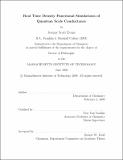| dc.contributor.advisor | Troy Van Voorhis. | en_US |
| dc.contributor.author | Evans, Jeremy Scott | en_US |
| dc.contributor.other | Massachusetts Institute of Technology. Dept. of Chemistry. | en_US |
| dc.date.accessioned | 2009-11-06T14:50:23Z | |
| dc.date.available | 2009-11-06T14:50:23Z | |
| dc.date.copyright | 2009 | en_US |
| dc.date.issued | 2009 | en_US |
| dc.identifier.uri | http://hdl.handle.net/1721.1/49547 | |
| dc.description | Thesis (Ph. D.)--Massachusetts Institute of Technology, Dept. of Chemistry, 2009. | en_US |
| dc.description | This electronic version was submitted by the student author. The certified thesis is available in the Institute Archives and Special Collections. | en_US |
| dc.description | Includes bibliographical references (p. 141-158). | en_US |
| dc.description.abstract | We study electronic conductance through single molecules by subjecting a molecular junction to a time dependent potential and propagating the electronic state in real time using time-dependent density functional theory (TDDFT). This is in contrast with the more common steady-state nonequilibrium Green's function (NEGF) method. We start by examining quantum scale conductance methods in both the steady state and real-time formulations followed by a review of computational quantum chemistry methods. We then develop the real-time density functional theory and numerical solution techniques and use them to examine transport in a simple trans-polyacetylene wire. The remaining chapters are devoted to examining real-time transport behavior of various systems and model chemistries. Open-shell calculation of the polyacetylene wire reveal that, in agreement with various correlated model calculations, charge and spin behave as separate quasiparticles with different rates of transport. However, the transport of charge, and especially spin are highly dependent upon the amount of exact exchange included in the approximate exchange-correlation energy functional. This functional dependence is further illustrated when we demonstrate that the conductance gap of a device imperfectly coupled to wires varies based upon the non-local exchange and correlation. We also study the dynamic transport behavior of benzene-1,4-dithiol (BDT) coupled to gold leads and find that both the transient current and device charge density fluctuate with time,. This suggests that the steady-state assumption of the NEGF method may not be accurate. | en_US |
| dc.description.statementofresponsibility | by Jeremy Scott Evans. | en_US |
| dc.format.extent | 158, 3 p. | en_US |
| dc.language.iso | eng | en_US |
| dc.publisher | Massachusetts Institute of Technology | en_US |
| dc.rights | M.I.T. theses are protected by
copyright. They may be viewed from this source for any purpose, but
reproduction or distribution in any format is prohibited without written
permission. See provided URL for inquiries about permission. | en_US |
| dc.rights.uri | http://dspace.mit.edu/handle/1721.1/7582 | en_US |
| dc.subject | Chemistry. | en_US |
| dc.title | Real time density functional simulations of quantum scale conductance | en_US |
| dc.type | Thesis | en_US |
| dc.description.degree | Ph.D. | en_US |
| dc.contributor.department | Massachusetts Institute of Technology. Department of Chemistry | |
| dc.identifier.oclc | 454439963 | en_US |
